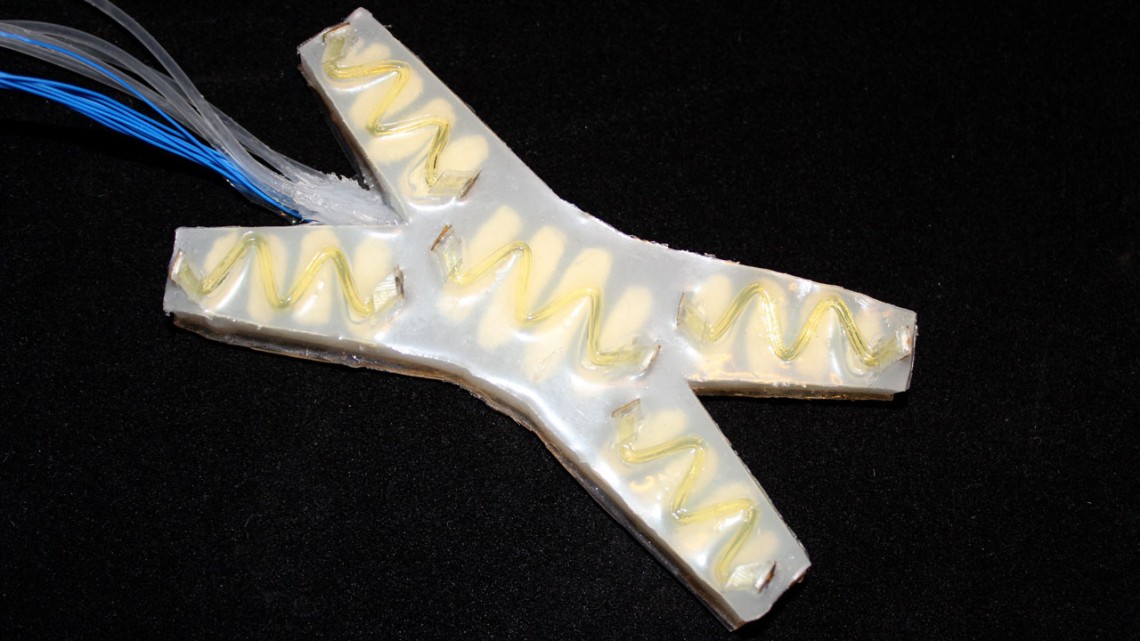
Researchers installed SHeaLDS – self-healing light guides for dynamic sensing – in a soft robot resembling a four-legged starfish and equipped with feedback control. After the researchers punctured one of its legs, the robot was able to detect the damage and self-heal the cuts.
Soft robot detects damage and heals itself
By David Nutt, Cornell Chronicle
If robots are going to venture into remote environments that humans can’t reach, such as deep underwater or distant outer space, they won’t only require power and a means to get there. They’ll also need to take good care of themselves.
To that end, a team led by Rob Shepherd, associate professor of mechanical and aerospace engineering in Cornell Engineering, combined optical sensors with a composite material to create a soft robot that can detect when and where it was damaged – and then heal itself on the spot.
Their paper, “Autonomous Self-Healing Optical Sensors for Damage Intelligent Soft-Bodied Systems,” published Dec. 7 in Science Advances. The lead author is doctoral student Hedan Bai.
“Our lab is always trying to make robots more enduring and agile, so they operate longer with more capabilities,” Shepherd said. “The thing is, if you make robots operate for a long time, they’re going to accumulate damage. And so how can we allow them to repair or deal with that damage?”
The first step for such a repair to occur is that the robot must be able to identify that there is, in fact, something that needs to be fixed.
For years, Shepherd’s Organic Robotics Lab has used stretchable fiber-optic sensors to make soft robots and related components – from skin to wearable technology – as nimble and practical as possible.
In fiber-optic sensors, light from a LED is sent through an optical waveguide, and a photodiode detects changes in the beam’s intensity to determine when the material is being deformed. One of the virtues of the technology is that waveguides are still able to propagate light if they are punctured or cut.
The researchers combined the sensors with a polyurethane urea elastomer that incorporated hydrogen bonds, for rapid healing, and disulfide exchanges, for strength.
The resulting SHeaLDS – self-healing light guides for dynamic sensing – provide reliable dynamic sensing, are damage-resistant, and can self-heal from cuts at room temperature without any external intervention.
To demonstrate the technology, the researchers installed the SHeaLDS in a soft robot resembling a four-legged starfish and equipped with feedback control. After the researchers punctured one of its legs a total of six times, the robot was able to detect the damage and self-heal each cut in about a minute. The robot could also autonomously adapt its gait based on the damage it sensed.
While the material is sturdy, it is not indestructible.
“They have similar properties to human flesh,” Shepherd said. “You don’t heal well from burning, or from things with acid or heat, because that will change the chemical properties. But we can do a good job of healing from cuts.”
Shepherd plans to integrate the SHeaLDS with machine learning algorithms that recognize tactile events to eventually create “a very enduring robot that has a self-healing skin, but uses the same skin to feel its environment to be able to do more tasks.”
Doctoral student Young Seong Kim co-authored the paper.
The research was supported by the Air Force Office of Scientific Research, the NASA Innovative and Advanced Concepts program, and the National Science Foundation EFRI program.
The researchers made use of the Cornell NanoScale Facility, a member of the National Nanotechnology Coordinated Infrastructure, which is supported by the NSF; the Cornell Center for Materials Research, which is supported by the NSF’s MRSEC program; and the Cornell Energy Systems Institute.
Media Contact
Get Cornell news delivered right to your inbox.
Subscribe
